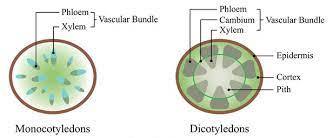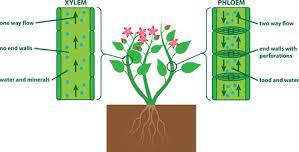XYLEM AND PHLOEM- TRANSPORT IN PLANTS
Transport in plants
Plants have tissues to transport water, nutrients and minerals. Xylem and Phloem are two different types of vascular tissues, which are mainly involved in the transportation process.
- Xylem transports water and mineral salts from the roots up to other parts of the plant, while phloem transports sucrose and amino acids from the leaves to other parts of the plant.
- Xylem moves water from roots to the leaves (Transpiration stream), and phloem moves food from the leaves to the rest of the plant (Translocation).
- The movement of xylem is unidirectional, while the movement of phloem is bidirectional.


Vascular bundles
Xylem and phloem tissues are found in vascular bundles which are found in vascular plants. The position of vascular bundles varies in different parts of the plant. In a leaf, the phloem is usually found closer to the lower surface.
Xylem
Mature xylem consists of elongated dead cells, arranged end to end to form continuous vessels (tubes). These vessels are impermeable to water, contain no cytoplasm, and have tough walls containing a woody material called lignin.
Water moves through the xylem vessels in a continuous transpiration stream:
Root → Stem → Leaf
Phloem
Phloem consists of living cells arranged end to end. Unlike xylem, phloem vessels contain cytoplasm, and this goes through holes from one cell to the next.
Phloem transports sucrose and amino acids up and down the plant called translocation. It also means translocation of food from source (generally leaves) to sink (generally grain).
Applied chemicals also move through the plant by translocation.
Differences between Xylem and Phloem
Xylem Phloem Mature xylem consists of elongated dead cells, arranged end to end to form continuous vessels (tubes). Phloem consists of living cells arranged end to end. They live with hollow dead cells. They live with cytoplasm without the nucleus. It is located in the centre of the vascular bundle. It is located on the outer side of the vascular bundle. Xylem fibres are smaller. Phloem fibres are larger. Movement is unidirectional (upward) These tissues move in a Bidirectional. (Both ways – up and down) Xylem transports water and mineral salts from the roots up to other parts of the plant. Phloem transports sucrose and amino acids from the leaves to other parts of the plant Provides mechanical support to the plant and helps in strengthening the stem. Translocates the synthesized sugars from source areas of plants to storage organs like, roots, bulbs and tubers.
Frequently Asked Questions (FAQ)
Where are the xylem and phloem located?
The xylem is located towards the adaxial surface of the leaf, whereas, phloem is located towards the abaxial surface of the leaf.
What are the functions of xylem and phloem?
Xylem transports water and mineral salts from the roots up to other parts of the plant, while phloem transports sucrose and amino acids from the leaves to other parts of the plant.
Why are the phloem cells alive?
The cells that make up the phloem tissues need to be alive to facilitate the active transport of sucrose throughout the plant.
Read also…
DIFFERENCE BETWEEN DIFFUSION AND OSMOSIS
Aadhar Card Download
PHOTOPERIODISM & VERNALIZATION